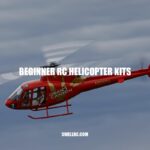Exploring the World of RC Model Cars
RC model cars have long been a popular hobby for kids and adults alike. These miniature vehicles are often more than just toys; they are sophisticated machines that can provide hours of entertainment, challenge, and learning. Whether you’re interested in off-road or on-road models, electric or nitro-powered options, stock or customized designs, or competitive or casual playing, there’s an RC car out there for you. In this article, we’ll explore the world of RC model cars: their history, types, components, modifications, and competitions. We’ll also look at why this hobby is becoming increasingly popular among enthusiasts worldwide, as well as some tips on how to get started. So, whether you’re a seasoned RC racer or a beginner looking for a fun and exciting pastime, read on to learn more about the world of RC model cars.
Types of RC Model Cars
There are many different types of RC model cars available on the market today. Here are a few of the most popular categories:
- Off-Road RC Cars: Designed for rough terrain, such as dirt tracks, sand dunes, or rock piles. These cars have high ground clearance, large tires with deep treads, and durable suspension systems. Examples include Traxxas Slash, Associated SC10, and HPI Sprint 2.
- On-Road RC Cars: Designed for smooth surfaces, such as pavement or indoor tracks. These cars have low ground clearance, small tires with slick treads, and agile handling. Examples include touring cars, drift cars, and formula cars.
- Electric RC Cars: Powered by rechargeable batteries, these cars are quiet, clean, and easy to maintain. They use either brushed or brushless motors and can be ready to run (RTR) or require some assembly. Examples include the Traxxas Slash, the Associated SC10, and the HPI Sprint 2.
- Nitro-powered RC Cars: Powered by small internal combustion engines that run on a special fuel mixture. These cars are louder, faster, and more complex than electric cars, but require more maintenance and tuning. Examples include the HPI Savage, the Losi 8IGHT, and the Kyosho Inferno.
In addition to these types of cars, some RC hobbyists enjoy building their own cars from scratch or modifying existing cars to suit their personal preferences. There are many resources available online for RC enthusiasts, including websites, forums, and social media groups. Some notable ones include RCGroups.com, RC Driver magazine, and RCTech.net. Additionally, major hobby shops like Hobby Town and A Main Hobbies offer a wide selection of RC cars, parts, and accessories.
What types of RC cars are there?
There are several types of RC cars available in the market based on their build and design. Here are some popular ones:
- On-Road RC Cars: These are designed for smooth surfaces like pavement, concrete, and indoor tracks. They are often built with low ground clearance for stability at high speeds.
- Off-Road RC Cars: These are built to tackle rough terrain like dirt, gravel, and rocky trails. They feature higher ground clearance, large tires with deep treads, and suspension systems to absorb shock.
- Drift RC Cars: These are specially designed for drifting. They have smooth tires and lowered suspension for maximum control during high-speed turns, slides, and drifts.
- Crawlers: These RC cars are perfect for scaling steep inclines, rocky terrain, and harsh environments. They have high ground clearance, soft tires, and superior suspension systems that allow them to navigate over obstacles with ease.
If you’re looking to purchase an RC car, you can check out websites like Amazon, HobbyTron, and Horizon Hobby for a wide range of options.
Building and Customizing RC Model Cars
While many hobbyists enjoy buying ready-to-run (RTR) RC cars, others prefer to build or customize their own models. This can be a rewarding and challenging aspect of the hobby that allows for greater personalization and creativity. Here are some things to consider when building or customizing an RC model car:
- Chassis: The base of the car, which provides structural support and determines the wheelbase, ground clearance, and weight distribution. Chassis can be made from materials like aluminum, carbon fiber, or plastic.
- Drive Train: The system of gears, shafts, and axles that transfer power from the motor to the wheels. Drive trains can be designed for maximum speed, torque, or efficiency.
- Motor and ESC: The motor is the heart of the car, and provides power to turn the wheels. The Electronic Speed Controller (ESC) regulates the motor’s speed and direction. Both electric and nitro-powered cars require a motor and ESC.
- Suspension: The system of springs, shocks, and arms that absorb bumps and keep the wheels in contact with the ground. Suspension can be customized for different types of terrain and driving styles.
- Body: The outer shell of the car, which can be made from polycarbonate or other plastics. Bodies can be painted and decorated to create a unique look, or to replicate real-life racing vehicles.
There are many resources available online for hobbyists who want to build or customize their own RC cars. Websites like RCUniverse.com and RCCarTips.com offer tutorials, forums, and product reviews. Additionally, there are many specialized tools and accessories available for building and tuning RC cars, such as shock wrenches, alignment tools, and motor analyzers. Here is an example of some common RC tools and their uses in a table:
| Tool Name | Use |
|---|---|
| Hex Driver | Used to tighten or loosen screws with hexagonal heads. |
| Body Reamer | Used to create holes in the body for mounting accessories. |
| Turnbuckle Wrench | Used to adjust the length of turnbuckles, which affect the alignment of the wheels. |
| Wheel Nut Driver | Used to tighten or loosen the nuts that hold the wheels onto the axle. |
Can you build your own RC car?
Yes, you can certainly build your own RC car! There are many different ways you can go about it, depending on your skill level and budget. Here are a few options to consider:
Build from scratch:
If you’re feeling ambitious and want to start completely from scratch, you can purchase individual components and build your own custom RC car. This will require some technical know-how and a lot of patience, but it can be a rewarding and fun project. You can find all the necessary parts and components at websites like HobbyKing, Tower Hobbies or AliExpress.
Kit:
You can also purchase a pre-made kit, which will come with all the necessary parts and instructions for assembling your own RC car. This is a great option for beginners or those who want to get started quickly without having to source all the parts individually. Websites like Amazon, Banggood and Horizon Hobby have a great selection of RC car kits to choose from.
Modification:
If you want to start with a pre-made RC car and make modifications to it, this is another option. You can purchase an off-the-shelf RC car and then customize it to your liking, whether that means changing the body, adding new components, or upgrading the motor and electronics. You can find all sorts of modification kits and accessories at websites like AMain Hobbies or RC Planet.
In any case, building your own RC car can be a fun and rewarding experience, and there are plenty of resources available to help you along the way.
Racing RC Model Cars
For many hobbyists, the thrill of RC model car racing is a big draw. These races can be informal local events or highly competitive national and international competitions. Here are some things to know about RC model car racing:
- Types of Races: There are several different types of RC model car races, including off-road, on-road, oval, and drag racing.
- Classes: Depending on the type of race and the skill level of the racers, there may be different classes for different types of cars. These classes may be based on factors like motor type, chassis material, or body style.
- Race Day: On race day, participants must adhere to certain rules and regulations, such as having a charged battery, using approved tires, and staying within designated lanes or boundaries.
- Scoring: Depending on the race format, scoring may be based on factors like lap times, number of laps completed, or position at the finish line.
There are many resources available for those interested in RC model car racing. National organizations like the International Federation of Model Auto Racing (IFMAR) and the Radio Control Car Action magazine (RCCA) offer news, reviews, and event calendars. Many local hobby shops and tracks offer beginner-friendly races and classes, as well as experienced guidance for those looking to take their racing skills to the next level. Here’s an example of a popular RC model car racing championship:
| Championship | Description |
|---|---|
| IFMAR World Championships | Biennial event that features the top RC model car racers from around the world, competing in different class and type races. |
What is the best RC car for speed?
If you are looking for a fast RC car, there are several options to choose from. Here are some of the best RC cars for speed:
- Traxxas XO-1 – This RC car is known for its incredible speed of over 100mph.
- Arrma Infraction 6S BLX – With a top speed of around 80mph, this RC car is another great option for those who want to experience high-speed driving.
- HPI Racing Trophy 3.5 Buggy – This RC car can reach speeds of up to 50mph, making it a great choice for those on a budget.
Additionally, you can visit websites like traxxas.com or horizonhobby.com to check out more options for high-speed RC cars.
Conclusion
In conclusion, RC model cars are a fun and engaging hobby for both kids and adults alike. With a wide variety of models available to suit different skill levels and interests, there is truly something for everyone. Whether you’re interested in building and customizing your own car or competing in high-stakes races, the possibilities are endless. There is also a vibrant online community of hobbyists and experts who are eager to share their knowledge, tips, and tricks with newcomers to the world of RC model cars. So why not give it a try? Who knows, you might just find yourself hooked on this exciting hobby!



